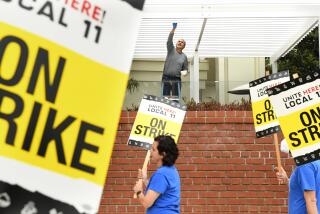Grocery strike averted: Workers reach tentative deal with Ralphs and Albertsons

Southern California grocery workers have reached a tentative labor agreement with the Ralphs and Albertsons chains. The move averts the immediate threat of a strike that could have roiled some of the region’s largest supermarket chains.
Rick Icaza, the president of United Food and Commercial Workers Union Local 770, said the two sides hammered out a deal Thursday. He declined to give further details until Monday, when union members are to vote on the package.
“For all intents and purposes, it’s over,” he said.
Ralphs spokeswoman Kendra Doyel said the company had proposed pay increases and changes to its pension and healthcare plans. She did not provide specifics on the deal.
“We remain committed to finding solutions that will be good for our associates and keep Ralphs competitive in the market,” she said in an emailed statement.
Albertsons, which includes the Vons and Pavilions chains, said the three-year deal “acknowledges the important contributions of our front-line employees, our most valuable asset, and allows our company to remain competitive.”
“We will continue to provide retail employees with pay that significantly exceeds the minimum wage, along with comprehensive health, welfare and pension benefits,” the company said in a statement.
The specter of the last major grocery strike, which started in 2003 and lasted 141 days, loomed over this year’s negotiations. That strike dealt heavy losses to both sides.
In June, about 47,000 clerks, meat cutters, stockers and other grocery workers across Southern California voted to authorize a strike against Ralphs and Albertsons if a deal wasn’t reached by Aug. 8.
At the time, the chains wanted cuts to holiday pay, and proposed a raise of 10 cents an hour per worker over the next three years, union officials said. The chains also wanted to make it harder for entry-level employees to reach the highest pay grade of $20.10 an hour for a clerk, the officials said.
Union officials also said the stores would not fund healthcare beyond current levels, forcing employees to contribute more or sacrifice coverage; would reduce the companies’ future contributions to pensions; and would force employees to retire at 65 rather than 60.
Icaza said Thursday that both sides compromised, describing the final contract as “a give and take.”
“We are satisfied with the wages and benefits,” he said. “We are satisfied we are upholding our obligations” to workers.
By reaching a deal, the grocers and their workers avoided a disaster, said Burt Flickinger III, managing director of the retail consulting firm Strategic Resource Group. The big chains hemorrhaged market share during the 2003-04 strike and have never fully recovered. The strike cleared the way for the expansion of ethnic grocery stores and the entry of new chains into the region.
Even in a short strike — say, a week or less — Albertsons and Ralphs would have lost about 2% to 3% of the Southland market, Flickinger said. If the strike stretched on for months, about 10% of the region might have permanently slipped away to non-union rivals such as Costco, Whole Foods and Trader Joe’s.
Flickinger said workers would have suffered as well. In the 2003-04 strike, workers drew from unemployment and a union strike fund, but most did not get as much as they earned working normally. The same thing would have happened this time if a strike dragged on for months, he said.
ALSO
As new apartments flood downtown L.A., landlords offer sweet deals
How the nation’s largest security-guard firm adapts to changing threats
Not a sports fan? Dish Network lets subscribers drop ESPN, cutting prices
UPDATES:
2:45 p.m.: This article was updated with comments from Burt Flickinger III.
3:35 p.m.: This article was updated with additional comments and analysis.
This article was originally published at 2:20 p.m.







